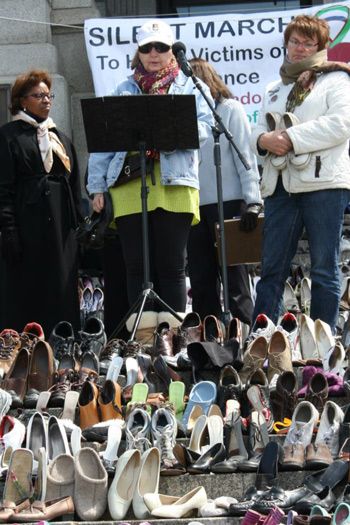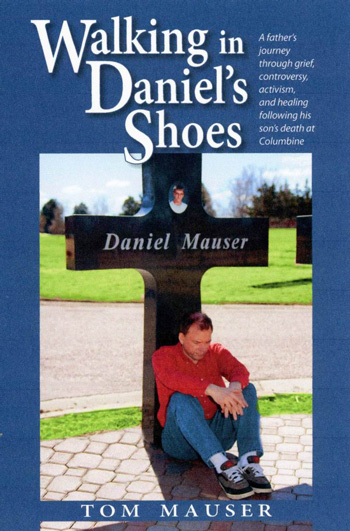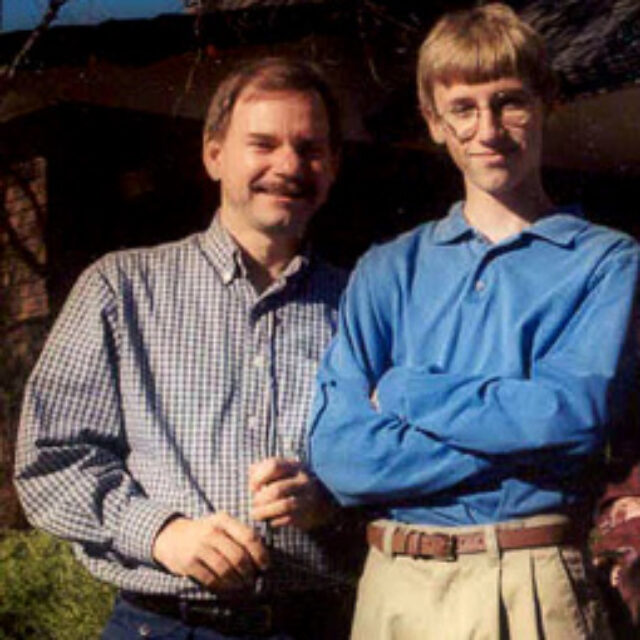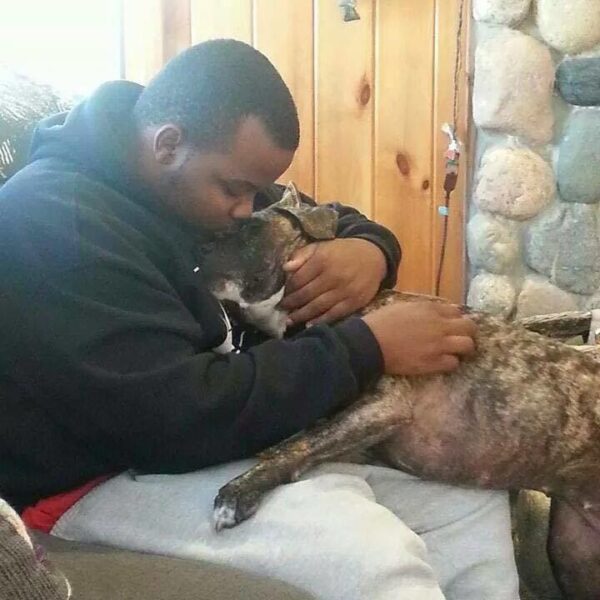Note: This essay is adapted from excerpts from Tom Mauser’s book, Walking in Daniel’s Shoes, and was originally published 14 years after the April 20, 1999 mass shooting at Columbine High School in Colorado.
This is a story about a father’s love for his son. It is a story of one victim of gun violence in a nation infested with an epidemic of gun violence.
I hope [my] book provides an understanding of what it’s like to be in the middle of such a high-profile tragedy. I hope it convinces more people to become active in changing our gun laws and our social attitudes towards guns. I hope it provides a helpful glimpse of my experience to others who are dealing with grief. Finally, I hope [my] book succeeds in demonstrating how a father’s love for his son can drive him to demand change in the world around him.
Why did it take fourteen years to write this book? For one thing, it wasn’t clear to me when my story of Columbine ended—it’s something I’ve been living ever since April 20, 1999.
April 20, 1999
Sometime around noon a coworker came into my office wearing a concerned look on her face. I was running late [to a meeting] and hoped her interruption was a brief one.
“You live in South Jefferson County, don’t you?” she asked.
“Yes.”
“And you have teenaged kids?”
“Yes.”
“And do they go to Columbine High School?”
“Yes,” I told her, “my son Daniel goes there.”
She urged me to come to the conference room, saying that something was happening at Columbine High School. I reluctantly agreed to join her. In the room, the television was on and ten or twenty people were gathered watching news coverage. Having employees watching news coverage was unheard of in our offices. It was fairly hushed, and all eyes were focused intently on the TV screen. On the news, helicopters were buzzing around. Police had surrounded the school. It was reported that shots had been fired. Shots were fired? How could that be?
My son was dead. How the hell could he be dead? I just saw him the day before. All we did was send him to school.
Then the images of students fleeing the school grounds, and parents hugging terrified teenagers. Word must have gotten around that I had a child at Columbine. I sensed some people looking at me with concern.
A colleague dropped me off at home. When I walked into our house, [my wife] Linda was wearing a deeply concerned expression on her face. Questions started frantically flying between us. Where was Daniel? Why hadn’t he called? In what room would he have been when the crisis started? With the phone lines so busy, would he have been able to call? And if he had escaped, how would he be able to get home since he didn’t drive yet?
[After an anguish-filled day,] the doorbell rang at about 11:00 p.m. It was a sheriff’s deputy. He said he still had no definitive news. He said there might still be students in the school, but authorities would not enter much of the building because of the potential for more bombs. They hoped to be able to get more information and call us in the morning. Not until the morning? [In the middle of the night, both of us unable to sleep], Linda put her arms around me, and we cried together. We both had already reached the conclusion that Daniel might no longer be with us on this earth.
It wasn’t until late morning that a sheriff’s deputy and two victims’ advocates came to the front door and asked to speak to Linda and me. We all stepped into the living room. They didn’t beat around the bush. They gave us the news we so dreaded: Daniel was dead.

My son was dead. How the hell could he be dead? I just saw him the day before. All we did was send him to school.
Fourteen years after the Columbine massacre, there are still people who are unclear about what happened there. At 11:14 a.m. on April 20, 1999, Eric David Harris, eighteen, and Dylan Bennett Klebold, seventeen, walked into the cafeteria at Columbine with murder on their minds. They carried two large duffle bags, each loaded with a 20-pound propane tank bomb, and placed them on the floor next to some tables and walked away, assuming they and the two bags would be unnoticed in a sea of students and backpacks. Harris and Klebold proceeded to their cars in the parking lot outside the cafeteria. Their plan was to wait for the explosion and then shoot survivors as they fled the building. The killers waited with two shotguns, a TEC 9 handgun, a Hi Point 9 mm carbine rifle, and 76 homemade explosives. The two propane bombs did not detonate[,] as the killers had planned. Many can be thankful for that. But having failed to wreak death and havoc, they decided to use the guns and other explosives to kill their classmates.
At 11:27 a.m., the killers entered the hallway outside the library [having killed or wounded…]… At 11:29 a.m., the killers entered the library. Exact times of events are known because of the recording of [teacher Patty] Nielsen’s 911 call. [She was in the library and had ordered the students to get under the desks.] The killers shouted at the students to “Get up!” None of the 54 students rose. They fired one shot into the room as they entered, injuring one student. Then they shot and killed a student as they walked toward the west windows of the library. They shot out the windows as they took aim at the police and fleeing students. The police returned fire. It was like a war zone.
The killers obtained the weapons through a straw purchase at a gun show where no background check was required.
Then the library became an execution chamber, as the killers walked around taunting students, then shooting them. Some were shot and some were spared. Some who were shot were known to the killers. One spared student was in one of Harris’s classes but not a friend. Harris told him, “We’re killing people!” then asked him to leave. He did.
Near the end of the shooting spree in the library, Eric Harris approached Daniel, who, like the others, was hunkered down under a table. According to various reports from witnesses, Harris taunted Daniel by calling him a geek, and reportedly referred to him as “four eyes” because he wore glasses.
At 11:34:55 Eric Harris fired a bullet from the Hi Point Carbine. It pierced Daniel’s hand but probably was not life threatening. Daniel pushed a chair at Harris. Daniel paid for that act of defiance and self-defense, as Harris called out, “Get up!” and at 11:34:57 fired another bullet, this time into Daniel’s face. The bullet entered near his nose and traveled into his brain, likely killing him quickly. God rest his soul.

The public has heard the beginning portion of the 911 tape, as the killers entered the library. The public has not heard the tape thereafter, as the Columbine shooters went on their shooting spree in the library. It is a disturbing record of the sound of hell on earth, of hatred, of horror, of death. (In seven minutes, Eric Harris and Dylan Klebold killed ten students and wounded twelve others in the library.)
The families of the victims were given the opportunity to listen to the recording. [More than a year later] I chose to do so. I felt compelled to listen so that I could hear the sounds Daniel heard in his last moments of life.
It was one of the most disturbing experiences of my lifetime, listening as two monsters terrorized a group of innocent students and took sinister delight in killing them. I could hear students crying out in shock, screaming “Oh my God!” and I could hear the killers crying out, “Woo!” and “Yahoo!” I could hear many of the shots fired. I sat in disbelief as I listened to the momentary, horrific sounds that marked the end of ten human lives.
I also heard the shots fired at 11:34:55 and 11:34:57. I sat there thinking of how that second shot ended the life of my son. Could there possibly be a more horrific, solitary sound that a parent might hear?
The killers obtained the weapons through a straw purchase at a gun show where no background check was required.
Robyn Anderson was not charged with a crime for transferring the three guns she had bought in a straw purchase for the Columbine killers.
The Tanner Gun Show is a regular fixture in Denver, conducted a few weekends every year. Firearms are sold by both licensed dealers and private (unlicensed) sellers. The would-be killers examined guns and asked [Klebold’s friend, Robyn] Anderson to buy three guns they spotted. Two were shotguns, and one was a shorter gun, a Hi Point 9 mm Carbine. The killers assumed they needed Anderson to purchase the guns for them because she was eighteen and they were both seventeen at the time.
According to Anderson, the gun sellers should have known it was a straw purchase—a purchase by one person on behalf of another who is prohibited from making the purchase. She claimed it should have been clear because the killers were the ones who asked questions and checked out weapons.
Anderson purchased the firearms from a private seller, not a licensed dealer. She testified before a legislative panel that as she and the two boys walked through the gun show, Harris and Klebold “kept asking sellers if they were private or licensed. They wanted to buy their guns from someone who was private and not licensed because there would be no paperwork or background check…I was not asked any questions at all [she said]. There was no background check…I would not have bought a gun for Eric and Dylan if I had had to give any personal information or submit any kind of check at all.”
Robyn Anderson was not charged with a crime for transferring the three guns she had bought in a straw purchase for the Columbine killers.

Early in 1999 Klebold and Harris returned to the Tanner Gun Show. They met [two men], Philip Duran, a man they knew from the pizza restaurant [where they worked], and his friend, Mark Manes… Duran became the middleman in a deal to purchase an Intratek TEC DC-9 semi-automatic handgun from Manes. Because it was a handgun, rather than a long gun or rifle, it was illegal for Manes to sell it to minors, and illegal for Duran to act as middleman in arranging the sale. They would later be convicted and sent to jail for those crimes.
The killers [also] needed plenty of ammunition for their firearms. Harris ordered gun magazines (also known as ammunition clips) from a gun shop. In his journal he mentions that a clerk from Green Mountain Guns called his home. His father, who owned guns, answered the phone. When the clerk told the elder Harris, “Your clips are in,” he simply told the clerk he hadn’t ordered any clips. Eric wrote in his journal that his father never asked whether the caller had the right phone, and acknowledged that if either the clerk or his father had just asked another question or two, his plans might have been ruined.
On the day before the massacre, Harris rounded out their ammunition supply, picking up 100 rounds that Mark Manes had bought for him at a Kmart store for $25 – a purchase that would become a significant scene in Michael Moore’s documentary, Bowling for Columbine.





